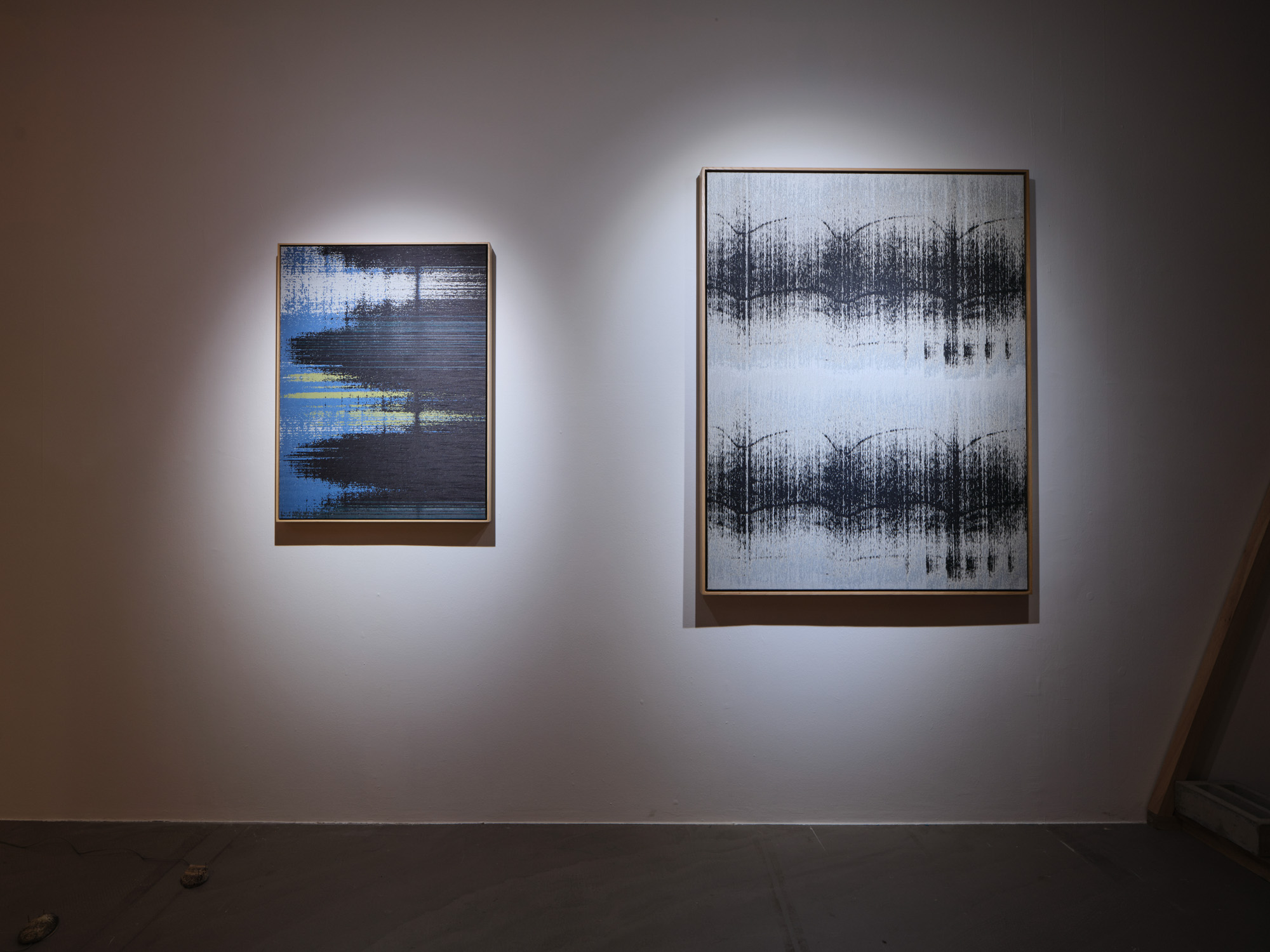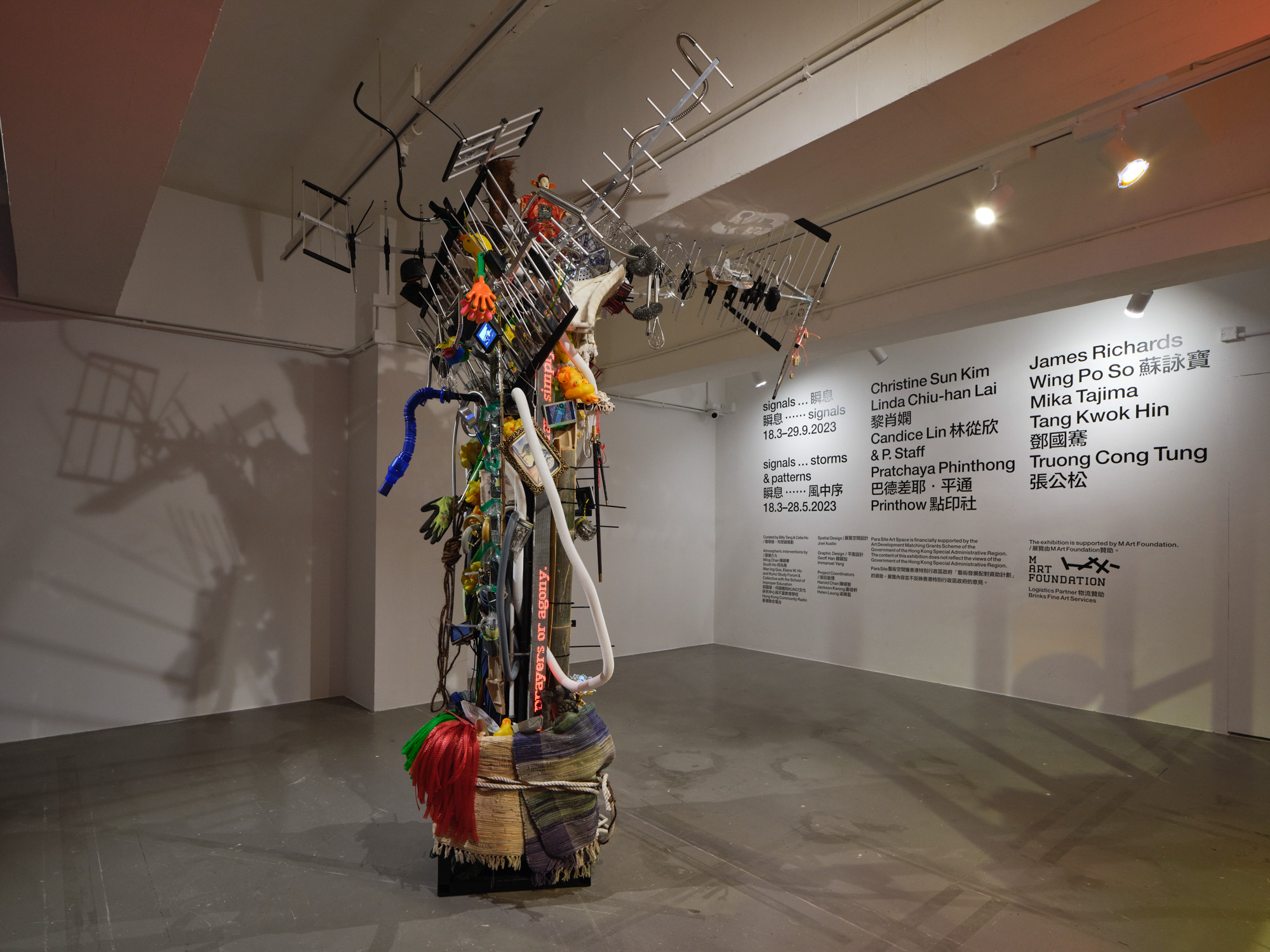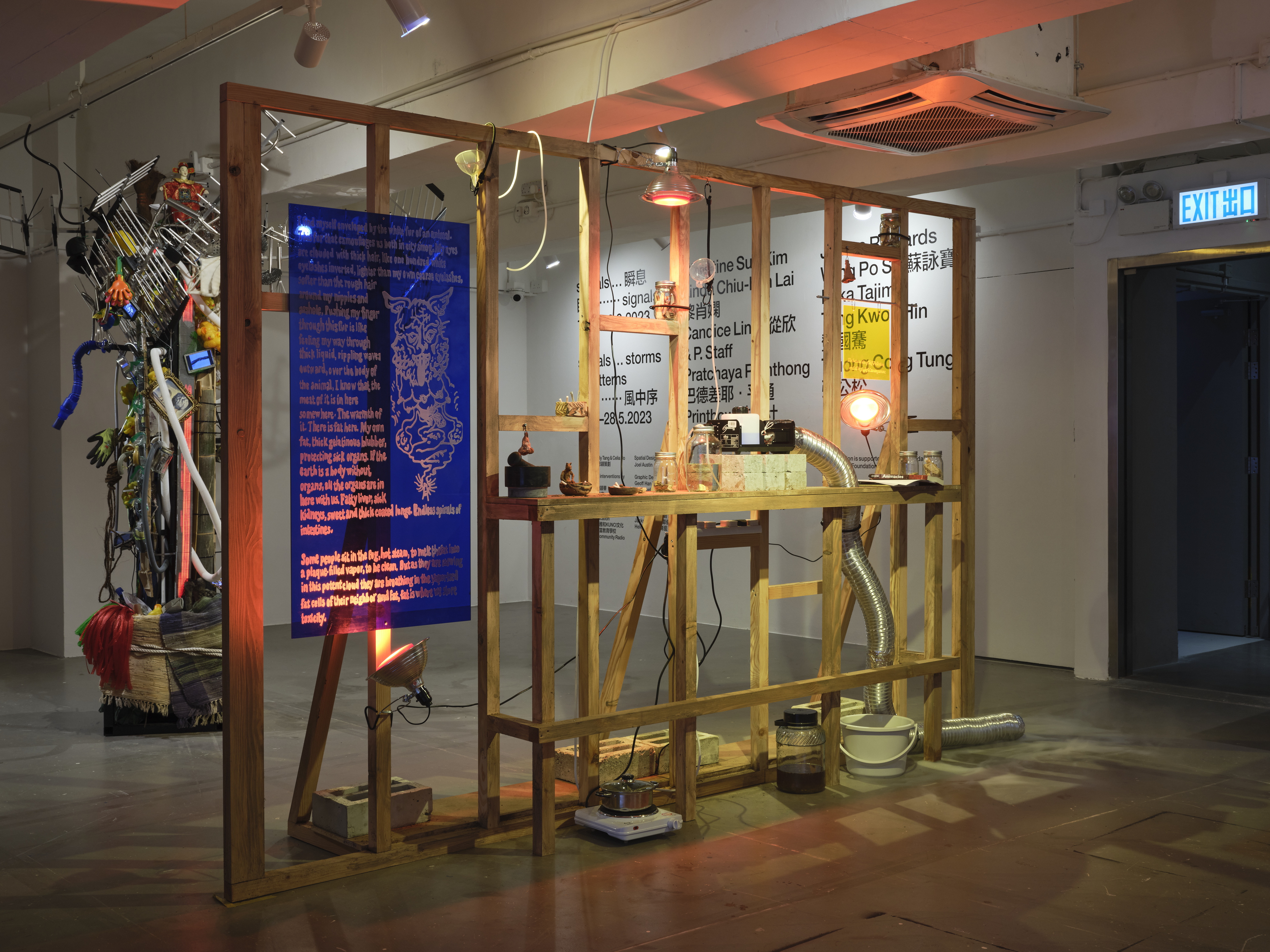Shows
Roundtable Review: “signals: storms and patterns” at Para Site

Co-curated by Billy Tang and Celia Ho, Hong Kong-based nonprofit Para Site’s latest group exhibition “signals . . . 瞬息” is an ambitious multipart project that examines modes of communication and interaction, primarily featuring kinetic art, multimedia installations, atmospheric interventions, as well as other new commissions in its three chapters spanning six months in 2023. The first chapter “storms and patterns,” opened on March 18 with more a dozen artists and other contributors, and delved into self-organization and the politics of space in contemporary art through sounds and smoke dispersed across the space. AAP’s editorial team members offer a few different takes on the exhibition.

“Flashes of excellence”
In a fast-paced city like Hong Kong, any artistic exploration into movement is bound to be interpreted relative to its surroundings, making Para Site’s latest multipart exhibition, “signals . . . 瞬息,” an ambitious endeavor from the start. The gallery space was well apportioned considering the disparate nature of many of the selected pieces, featuring colored lighting and several large-scale installations: an urban-industrial tree, olfactory tunnel, apothecary’s workshop, and the clicking of abalone shells. The gallery itself became a kinetic artwork. Unfortunately, this atmosphere may have made it difficult for individual pieces to compete with their environment, rendering them static in comparison. The standout artworks were those that anticipated and accounted for this stillness: Truong Cong Tung evoked the ambience of a fountain and the beliefs of the Vietnamese Jarai people in the cyclical movement of the spirit through stages of existence in the installation of lacquer-covered gourds and tubes The state of absence – voices from the outside (2020– ) with its use of subtle, repetitive motion. Likewise, Mika Tajima’s Jacquad-woven panels Negative Entropy (2022) resonated with the show’s theme despite their lack of apertures or motors. By recording ambient noise and converting her readings into colorful textiles, Tajima reverses the process of entropy and transforms a forgotten byproduct of the technological and industrial movement that surrounds us. Such an experimental show is bound to be divisive, but these flashes of excellence will undoubtedly be refined in subsequent installments of “signals” and can only serve to strengthen the unity between the artwork and their surroundings. BRYNN GORDON

“Mixed signals”
“Signals . . . 瞬息” gave me mixed signals. James Richards’s video Qualities of Life: Living in the Radiant Cold (2022) jolted me from hypnotic swirling images to a child discussing strangely biased points on “male” and “female” colonies, followed immediately by a pan up to a man’s genitals. Complemented by a trippy and at times overstimulating soundtrack, Richard’s video installation was a miss for me. On the other hand, I found Wing Po So’s floor installation Sea Ear Hi-hat (2020) a calming antidote. The abalone shells, positioned on the floor, slowly opened and closed, clacking in a syncopated rhythm. Intended to represent the spiral of the human ear, the shells were shaped more like lungs. They seemed to slowly inflate and deflate, prompting me to be mindful of my own breath. The wires which powered the movement twisted and waved forward, as if tracking the tidal motion that would have brought the shells to their current scattered placement. The mechanism of the artwork whirred slowly, perhaps to mimic the sound of the sea. GRACE JEFFERD

“Interesting but incongruent”
The first installment of Para Site’s ambitious exhibition trilogy, “storms and patterns,” promised to present works and artistic practices that explored the vast themes of the politics of space and different methods of self-organization. With such a curatorial scope, the artist lineup featured both local and international artists, as well as biennial regulars such as Pratchaya Phinthong, Truong Cong Tung, and Christine Sun Kim. It was a treat to see works by the Berlin-based Kim, who recently closed a solo exhibition at Vienna’s Secession and is participating in this year’s Gwangju Biennale, in Hong Kong. The practice of the multimedia artist, who was born Deaf, often incorporates elements of American Sign Language, visually translating and bridging the experiences of the Deaf community to the hearing. On view were three works by Kim: Six Debts (2022), Owe Owing Owe (2022), and Finger Palm Turquoise (2022). Charcoal-on-paper Owe Owing Owe, for example, consists of five black waves with the word “owing” written on the peaks and “owe” in the valleys, visually representing the idea of debt that Kim often investigates. In a show about signals and space, the works by Kim felt like a poignant point of representation of the different types of signals that occupy a space at once. Overall, save the small corner that Kim’s work occupied, the rest of the show presented individually interesting but incongruent works as a whole that signaled the vagueness of the curatorial intent. TIFFANY LUK

“Convincingly titled”
Experiencing Para Site’s latest exhibition felt very much like traversing a synoptic map—each work a meteorological station emitting cues of varying intensities and through different channels, alternatively clashing or dissipating across space. Near the entrance, Linda Chiu-han Lai’s maximalist assemblage of electronic signboards, rubber ducks, TV antennas, and more vied for attention with Candice Lin and P. Staff’s DIY fog-and-aroma-producing contraption, Hormonal Fog (2016–23). Nearby, drowsy vocalizations backgrounded by a lo-fi beat boomed beyond a makeshift wall—that would be James Richards’ trippy film, Qualities of Life: Living in the Radiant Cold (2022). If the opening felt like navigating a chaotic atmospheric trough, its following sections stabled into a ridge. Nonetheless, several works here required a closer and more sustained reading to prevent one from disengaging. Unfortunately, imposing tactile structures and curious whirring noises in the periphery drowned out Printhow’s richly detailed woodcut prints and Mika Tajima’s intricate, seismic fabric portraits. To its credit, “signals . . . 瞬息: storms and patterns” was convincingly titled. The exhibition delivered on its promises of spatiotemporal experimentation and efforts to reconnect with a wider group of global audiences through works by a group of international artists. Whether it succeeded in composing a coherent picture of “self-organization and the politics of space in contemporary art making,” however, remained subject to the audience’s individual preferences and capacities. TONG TUNG YENG

“Mechanical storm”
The Chinese idiom “瞬息萬變” (shun xi wan bian), which directly translates to “millions of changes in the second of a breath,” describes a rapidly evolving state. Incorporating the characters of “瞬息” (a breath) into its title, the first episode of Para Site’s latest exhibition appeared more as “萬變” (millions of changes) instead. In this self-transforming, slightly claustrophobic chaos, the relationship between the receiver and the enabler became blurred, which destabilized the position of the audience. The kinetic structure and ongoing crackling of Wing Po So’s abalone shells betrayed my childhood memories of trying to hear an echo from the hollow cavities. Rather than passive tunnels of sound, the shells here produce sounds and become active enablers in an overwhelmingly artificial way. It felt like I was leaving a mechanical storm when I walked toward the other end of the exhibition. Works by Pratchaya Phinthong and Truong Cong Tung were refreshing. The former are photographs featuring imagery resembling starry nights but are in fact created by capturing pinpoint-sized holes on lottery tickets, and the latter transfiguring system of gourds and water. Though their subject matter may sound paradoxical—opportunism in modern society and ancient highland myths of origins, celestial and terrestrial, respectively—their works felt in dialogue with the mountain outside of the window on the 22nd floor. The show prompted me to wonder if it was born in the breeze or in the gesture of holding one’s breath. Perhaps Candice Lin and P. Staff’s Hormonal Fog (2016–23) machine could explain if it hadn’t run out of fog. XIYUN WU

Looking at the “Signals gallery lineage”
How do we do things differently? And what are those things that we want to do? I took these to be the questions driving the first chapter in the multipart exhibition series “signals . . . 瞬息” curated by Billy Tang and Celia Ho, who announced that the exhibition marks a “new beginning” for the 27-year-old Hong Kong nonprofit. Of course, nothing is entirely new. The title refers, in part, back to the mid-1960s era Signals gallery in London, where an eclectic crew comprising critics such as Guy Brett and artists including Gustav Metzger (known for his “auto-destructive art”) and the mercurial David Medalla came together to ask similar questions by inviting international, experimental artists to show in Britain. That gallery’s name came from the kinetic sculptural works—usually in the form of tall rods topped with electrical devices—made by the Greek artist Panayiotis Vassilakis, who went by the mononym Takis. At Para Site, the Signals lineage or ethos felt embodied in numerous works including Linda Chiu-han Lai’s Tree of Life, iteration 2023 (2023), a tall sprouting sculpture of electronic cast-offs including TV antennas, a digital monitor, extension cords, a LED sign board, as well as cleaning equipment; like its biological name, it has grown over the years as Hong Kong’s urban debris forms more layers. A different strand of Signals gallery DNA can be traced through references to Medalla’s practice—particularly his “bubble machine” sculptures of tubes filled with foam that satirized modernist sculptural shibboleths about composition and form. Anti-form appears not only in Lai’s Tree of Life, but also in Candice Lin and collaborator P. Staff’s Hormonal Fog (2016–23), an installation of a wooden wall partition with a “hacked fog machine” that tampers with the gallery ecosystem, as well as in Truong Cong Tung’s installation The state of absence–voices from the outside (2020– ), which comprises water-circulating tubes that ran between the lacquer-painted gourds resting on shipping pallets. Perhaps most intriguing for me were how the many “forms” of transformation within the exhibition—like Lai’s tree or Tang Kwok Hin’s storage-cabinet-like installation Shoulder to Shoulder (2023)—are themselves destined to change in subsequent chapters. I’m also curious how the nonexhibitionary elements, such as Power Naps Post, the text-and-image collaboration by Wing Chan and South Ho, and radio broadcasts with Hong Kong Community Radio, might be received on different frequencies. HG MASTERS
Tiffany Luk is ArtAsiaPacific’s associate editor; Grace Jefferd is assistant editor; HG Masters is deputy editor; Brynn Gordon, Tong Tung Yeng, and Xiyun Wu are editorial interns.







